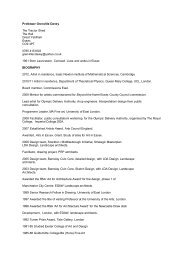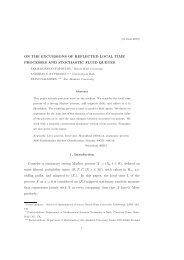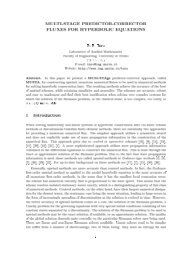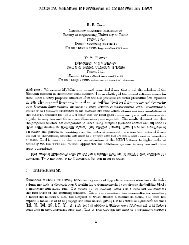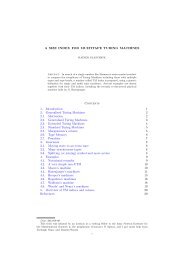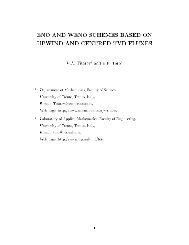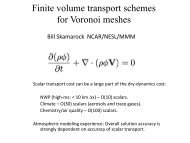Optimal Designs for the Prediction of Individual Effects in Random ...
Optimal Designs for the Prediction of Individual Effects in Random ...
Optimal Designs for the Prediction of Individual Effects in Random ...
You also want an ePaper? Increase the reach of your titles
YUMPU automatically turns print PDFs into web optimized ePapers that Google loves.
8 Maryna Prus and Ra<strong>in</strong>er Schwabe<br />
erage <strong>of</strong> <strong>the</strong> Bayesian and <strong>the</strong> “standard” counterparts <strong>in</strong> <strong>the</strong> case <strong>of</strong> prediction <strong>of</strong><br />
<strong>in</strong>dividual parameters and def<strong>in</strong>es, hence, a compound criterion. For <strong>the</strong> prediction<br />
<strong>of</strong> <strong>in</strong>dividual deviations <strong>the</strong> Bayesian optimal designs rema<strong>in</strong> optimal, while <strong>the</strong><br />
criteria differ by an additive constant.<br />
A generalization <strong>of</strong> <strong>the</strong> present results to s<strong>in</strong>gular dispersion matrices D is<br />
straight<strong>for</strong>ward, although <strong>the</strong>re is no Bayesian counterpart <strong>in</strong> that case and <strong>the</strong> <strong>for</strong>mulae<br />
become less appeal<strong>in</strong>g. Such s<strong>in</strong>gular dispersion matrices naturally occur, if<br />
only parts <strong>of</strong> <strong>the</strong> parameter vector are random and <strong>the</strong> rema<strong>in</strong><strong>in</strong>g l<strong>in</strong>ear comb<strong>in</strong>ations<br />
are constant across <strong>the</strong> population. In particular, <strong>in</strong> <strong>the</strong> case <strong>of</strong> a random <strong>in</strong>tercept<br />
model, when all o<strong>the</strong>r parameters are fixed, <strong>the</strong> optimal design <strong>for</strong> <strong>the</strong> prediction <strong>of</strong><br />
<strong>the</strong> <strong>in</strong>dividual parameters can be obta<strong>in</strong>ed as <strong>the</strong> optimal one <strong>in</strong> <strong>the</strong> correspond<strong>in</strong>g<br />
model without <strong>in</strong>dividual effects (Prus and Schwabe, 2011), while <strong>for</strong> prediction <strong>of</strong><br />
<strong>the</strong> <strong>in</strong>dividual deviations any mean<strong>in</strong>gful design will be optimal.<br />
The method proposed may be directly extended to o<strong>the</strong>r l<strong>in</strong>ear design criteria<br />
as well as to <strong>the</strong> class <strong>of</strong> Φq-criteria based on <strong>the</strong> eigenvalues <strong>of</strong> <strong>the</strong> mean squared<br />
error matrix. Although <strong>the</strong> design optimality presented here is <strong>for</strong>mulated <strong>for</strong> approximate<br />
designs, which generally may not be exactly realized. These optimal approximate<br />
designs can serve as a benchmark <strong>for</strong> candidates <strong>of</strong> exact designs, which<br />
<strong>for</strong> example are obta<strong>in</strong>ed by appropriate round<strong>in</strong>g <strong>of</strong> <strong>the</strong> optimal weights. <strong>Optimal</strong><br />
designs <strong>for</strong> situations, which allows <strong>for</strong> different <strong>in</strong>dividual designs, will be subject<br />
<strong>of</strong> future research, <strong>in</strong> particular, <strong>in</strong> <strong>the</strong> case <strong>of</strong> sparse sampl<strong>in</strong>g, where <strong>the</strong> number<br />
<strong>of</strong> observations per <strong>in</strong>dividual is less than <strong>the</strong> number <strong>of</strong> parameters.<br />
Acknowledgements This research was partially supported by grant SKAVOE 03SCPAB3 <strong>of</strong> <strong>the</strong><br />
German Federal M<strong>in</strong>istry <strong>of</strong> Education and Research (BMBF). Part <strong>of</strong> <strong>the</strong> work was done dur<strong>in</strong>g a<br />
visit at <strong>the</strong> International Newton Institute <strong>in</strong> Cambridge.<br />
References<br />
1. Fedorov, V., Hackl, P.: Model-Oriented Design <strong>of</strong> Experiments. Spr<strong>in</strong>ger, New York (1997)<br />
2. Gladitz, J., Pilz, J.: Construction <strong>of</strong> optimal designs <strong>in</strong> random coefficient regression models.<br />
Statistics 13, 371–385 (1982)<br />
3. Henderson, C. R.: Best l<strong>in</strong>ear unbiased estimation and prediction under a selection model.<br />
Biometrics 31, 423–477 (1975)<br />
4. Kiefer, J.: General equivalence <strong>the</strong>ory <strong>for</strong> optimum designs (approximate <strong>the</strong>ory). Annals <strong>of</strong><br />
Statistics 2, 849–879 (1974)<br />
5. Prus, M., Schwabe, R.: <strong>Optimal</strong> <strong>Designs</strong> <strong>for</strong> <strong>Individual</strong> <strong>Prediction</strong> <strong>in</strong> <strong>Random</strong> Coefficient<br />
Regression Models. In: V. Melas, G. Nachtmann and D. Rasch (Eds.): <strong>Optimal</strong> Design <strong>of</strong><br />
Experiments - Theory and Application: Proceed<strong>in</strong>gs <strong>of</strong> <strong>the</strong> International Conference <strong>in</strong> Honor<br />
<strong>of</strong> <strong>the</strong> late Jagdish Srivastava, pp. 122–129. Center <strong>of</strong> Experimental Design, University <strong>of</strong><br />
Natural Resources and Life Sciences, Vienna (2011)<br />
6. Silvey, S. D.: <strong>Optimal</strong> Design. Chapman & Hall, London (1980)




